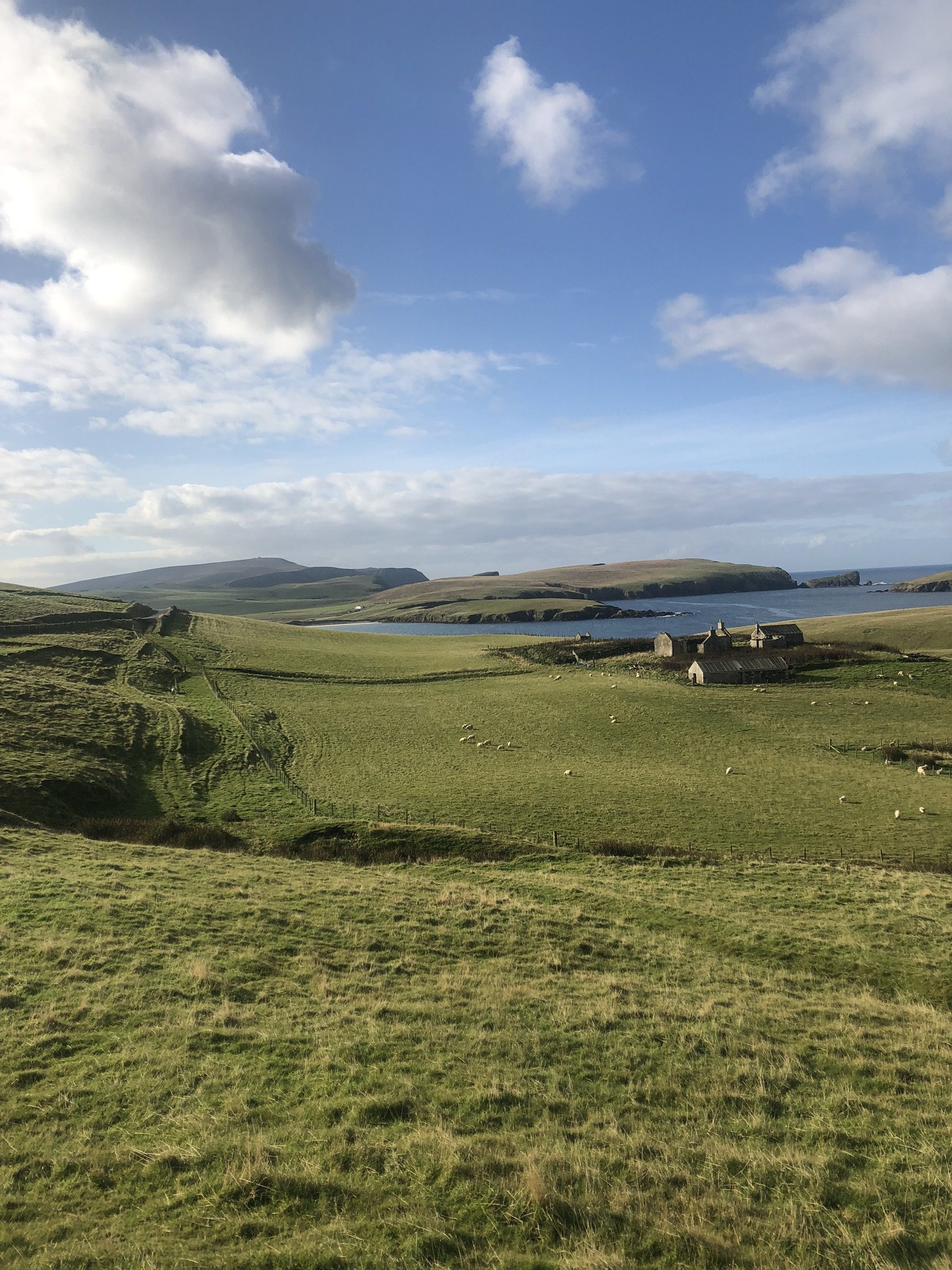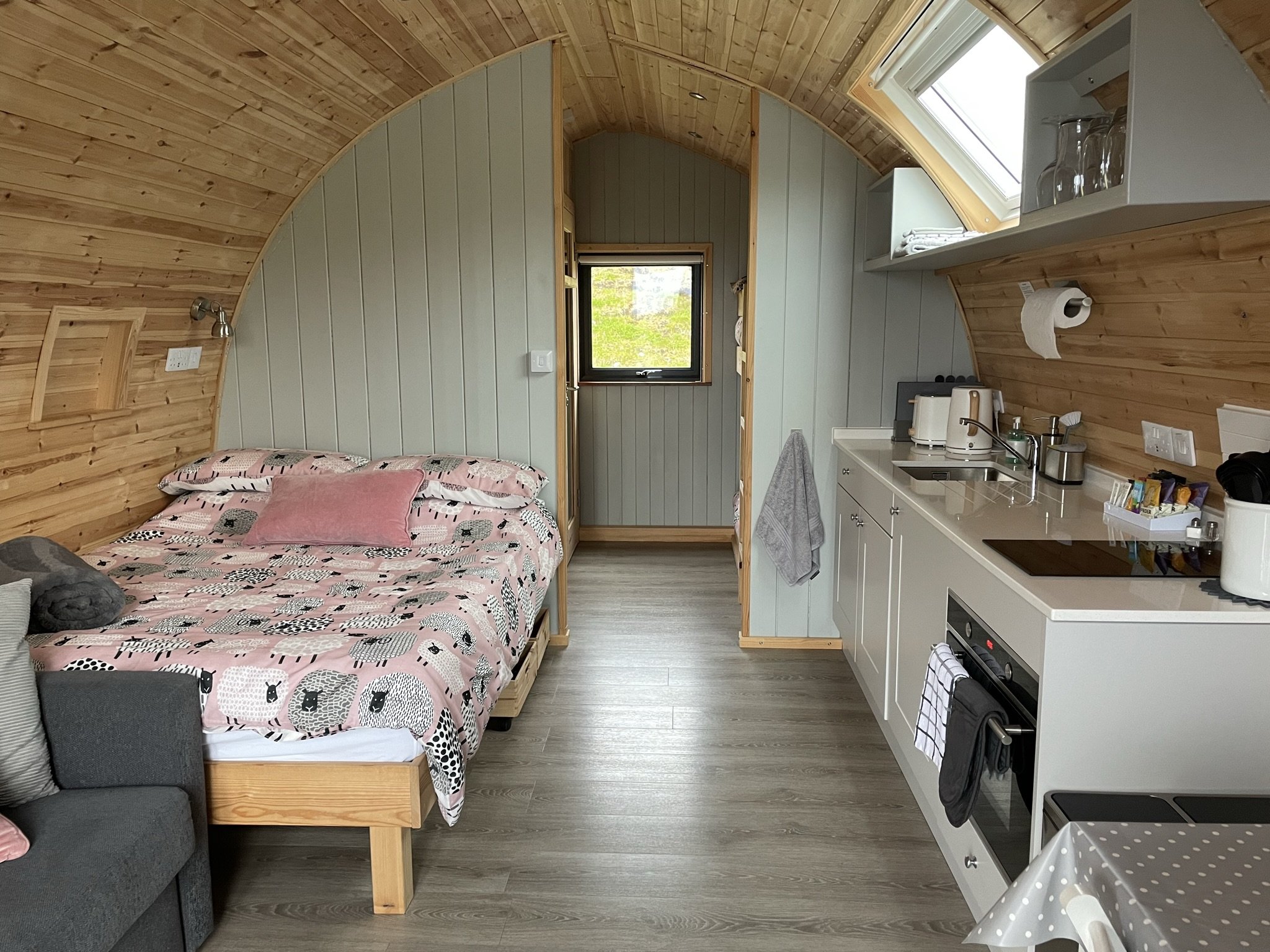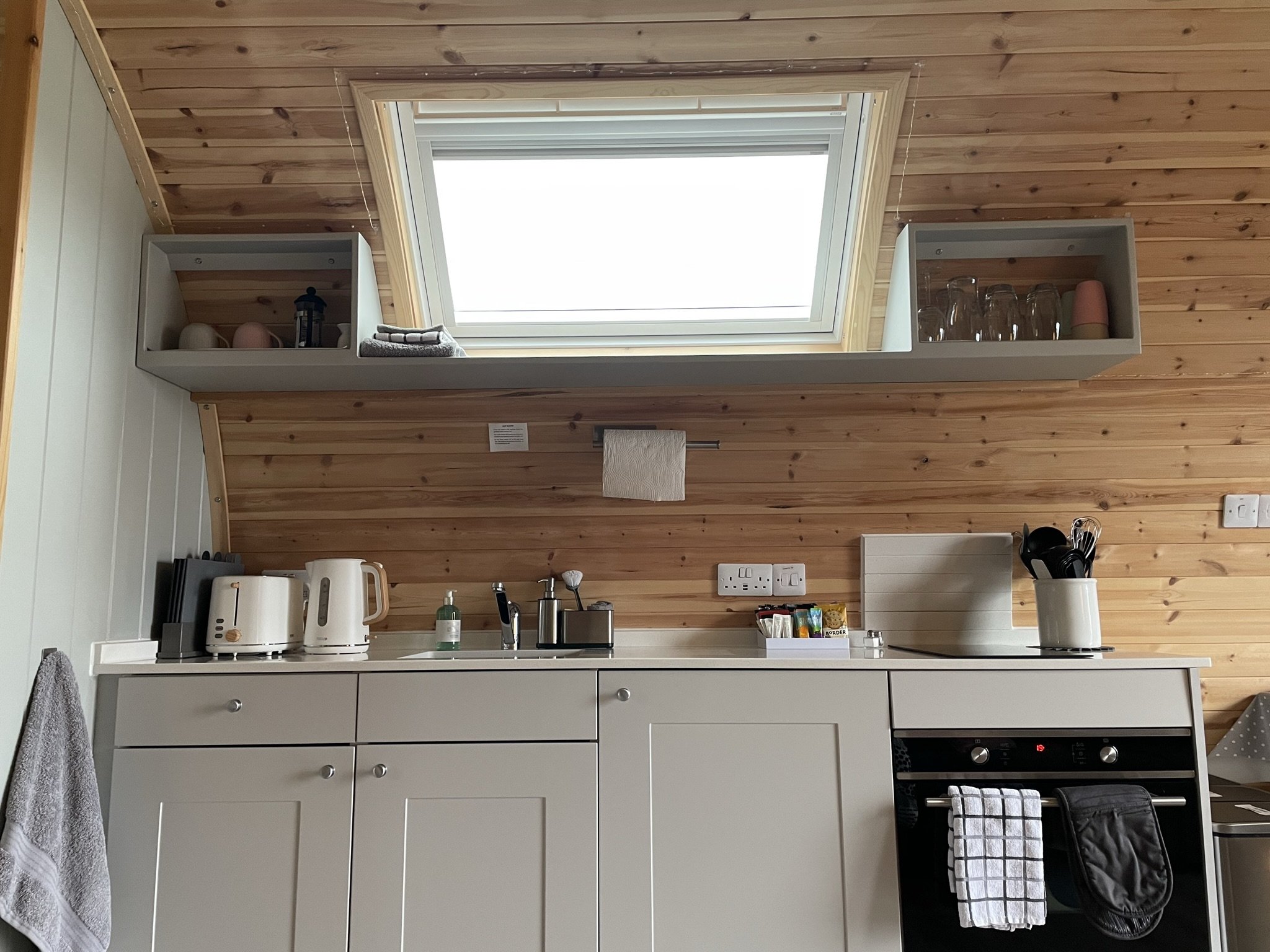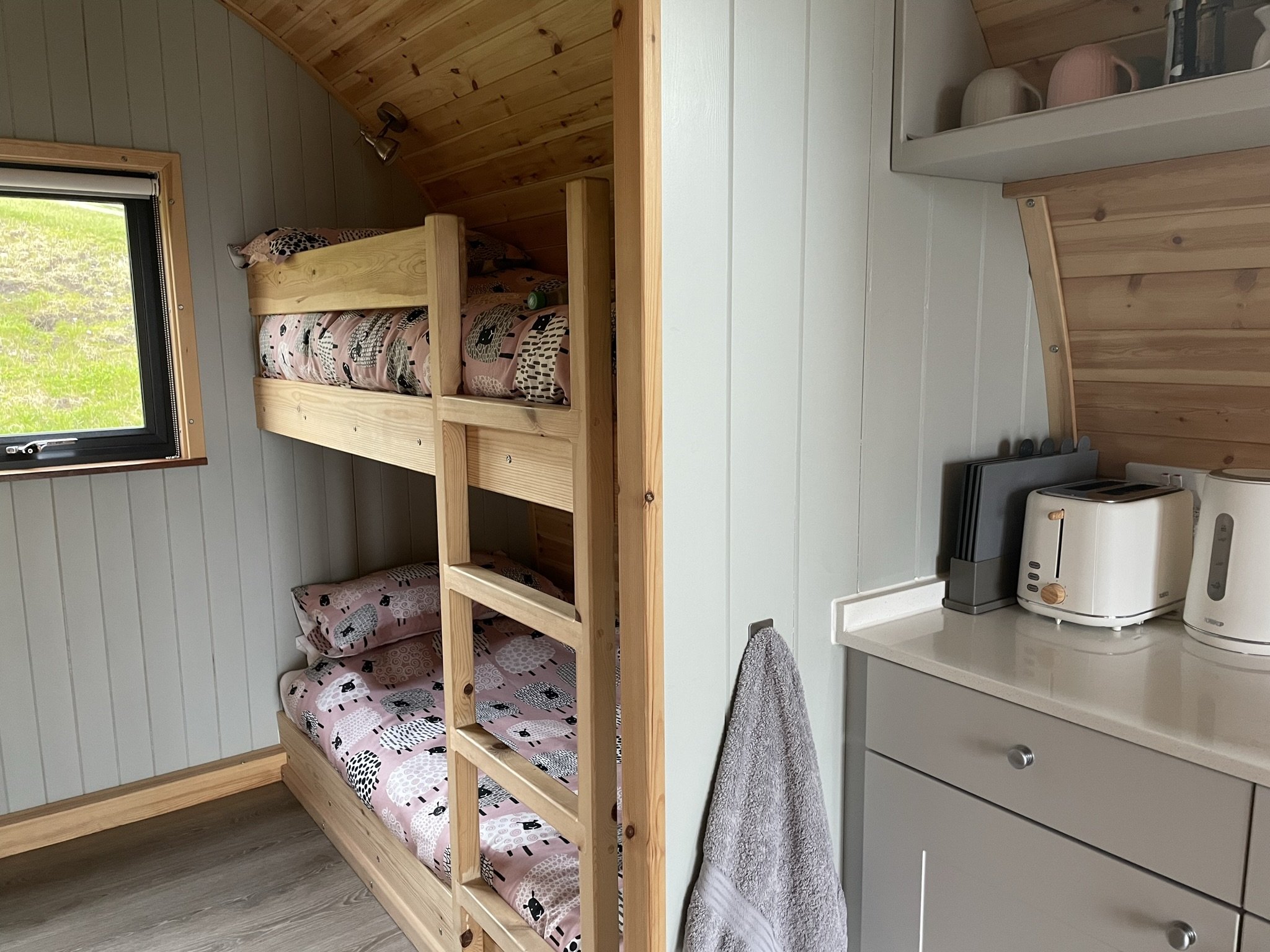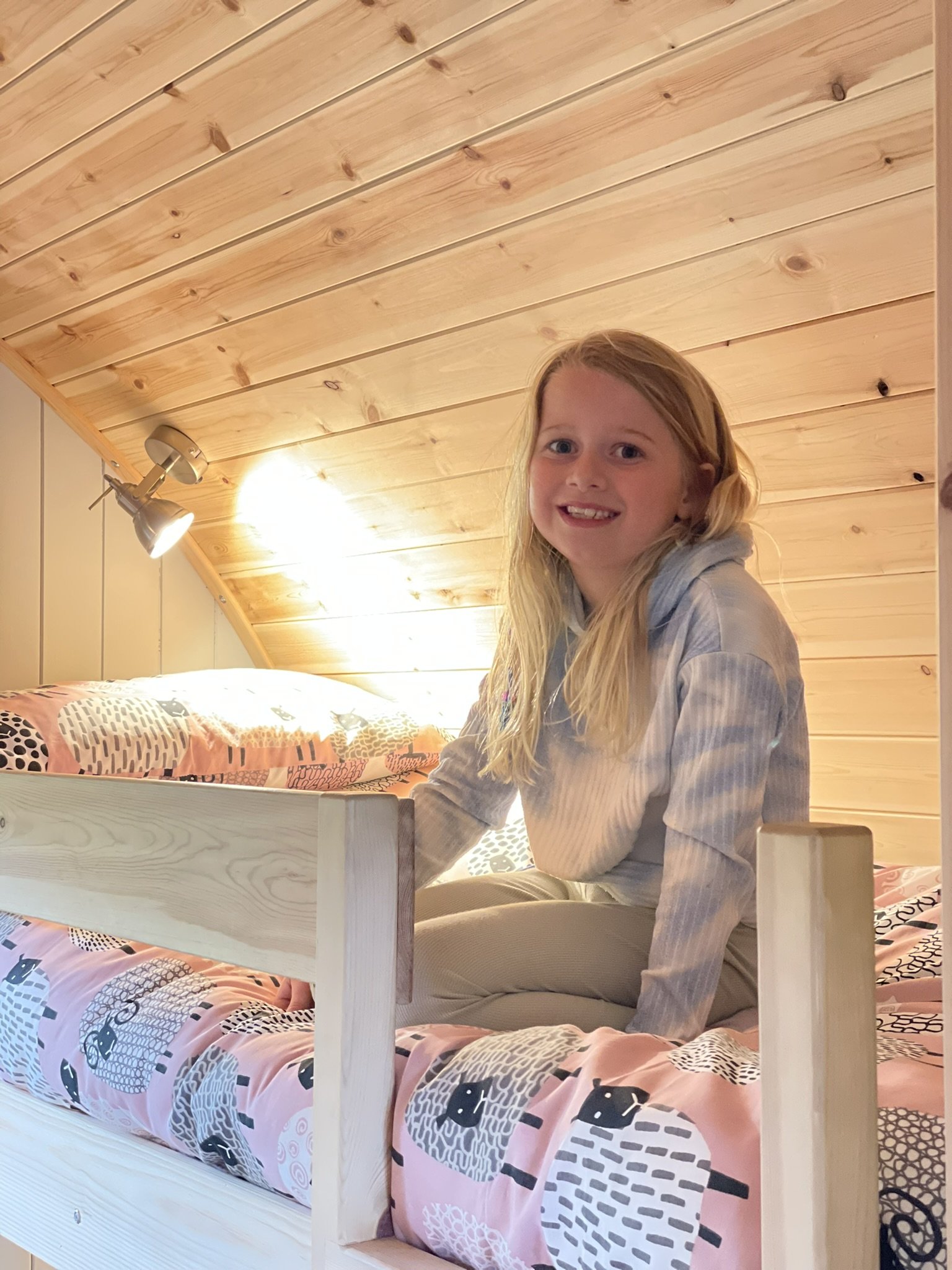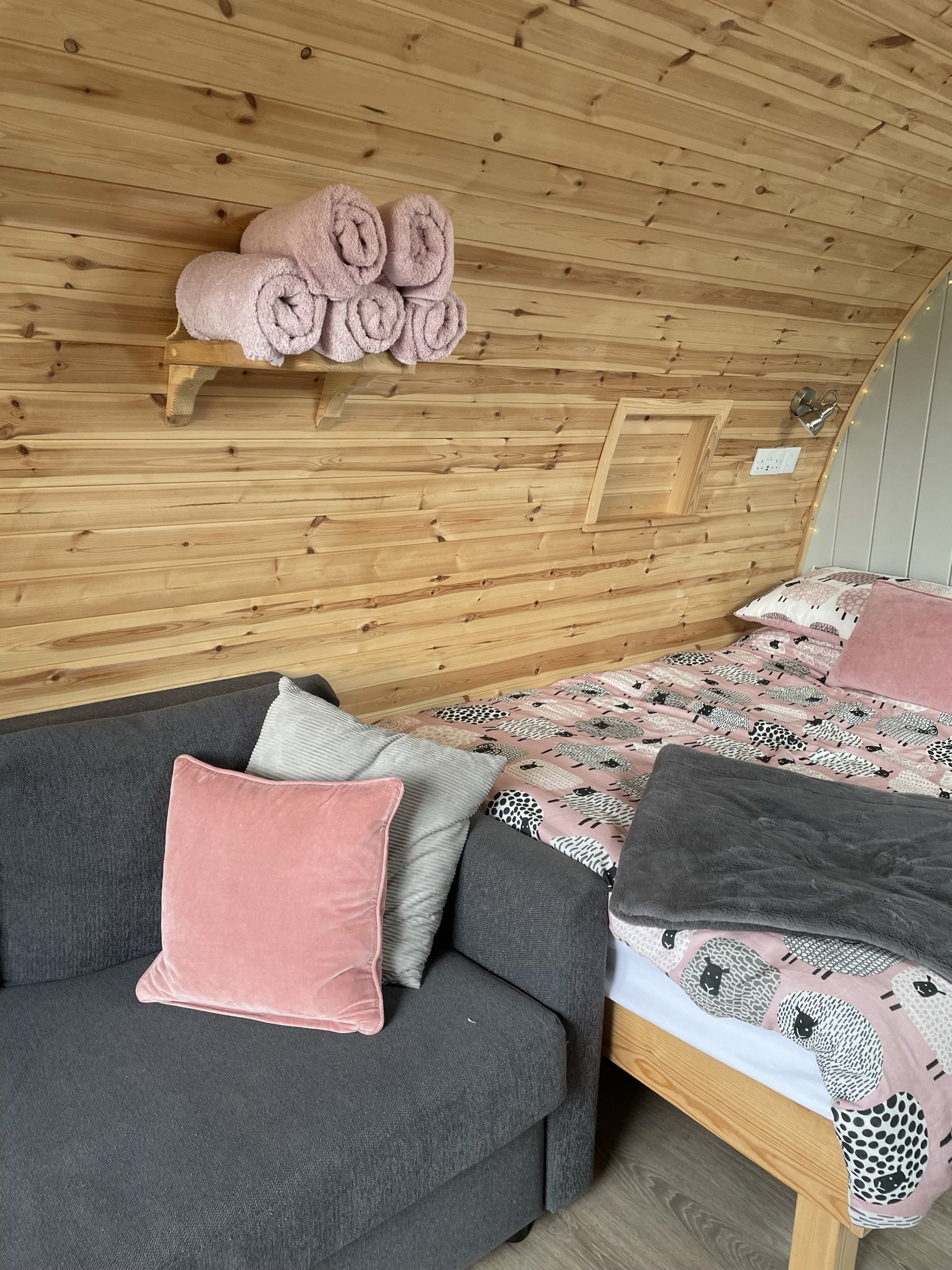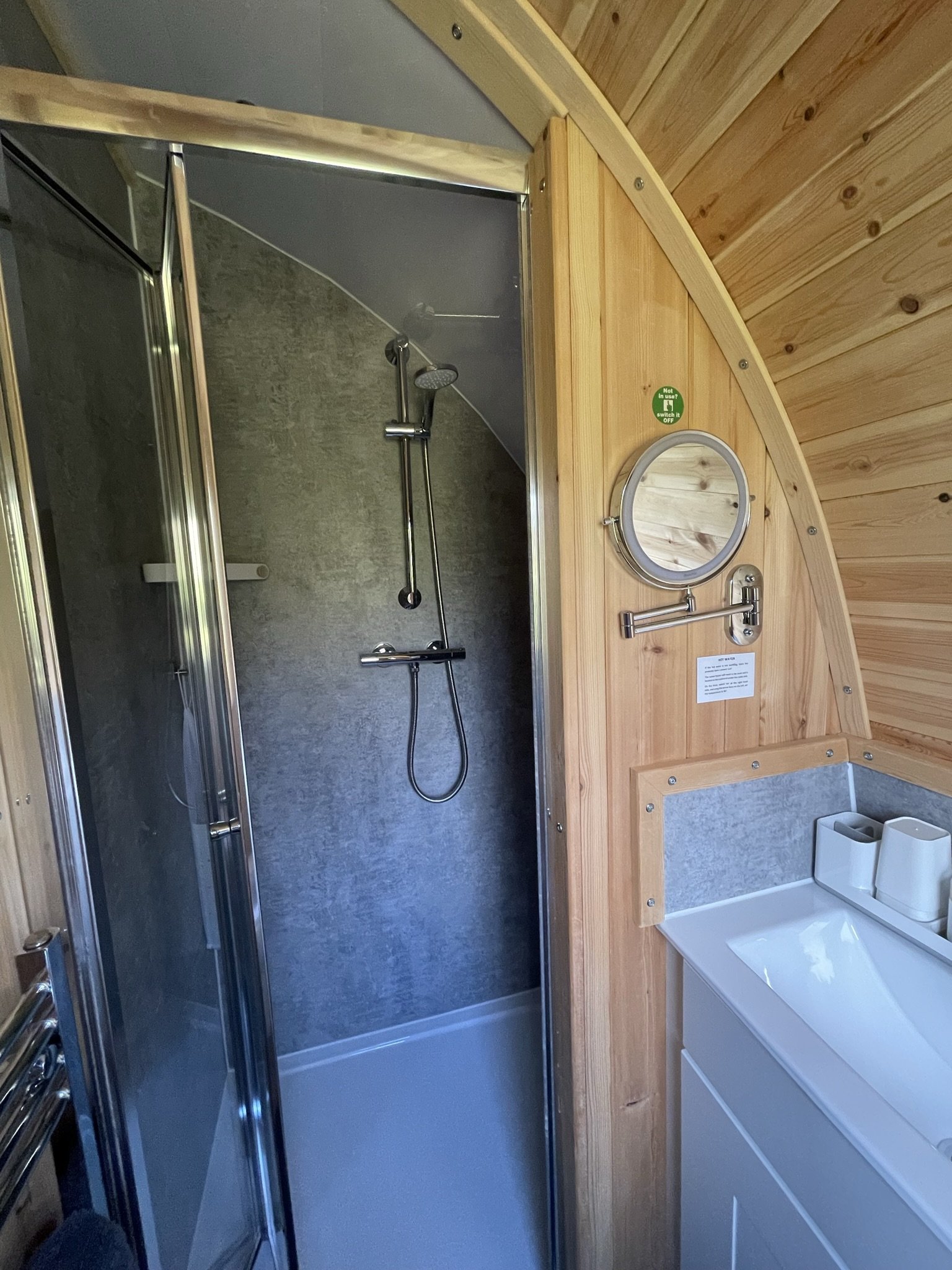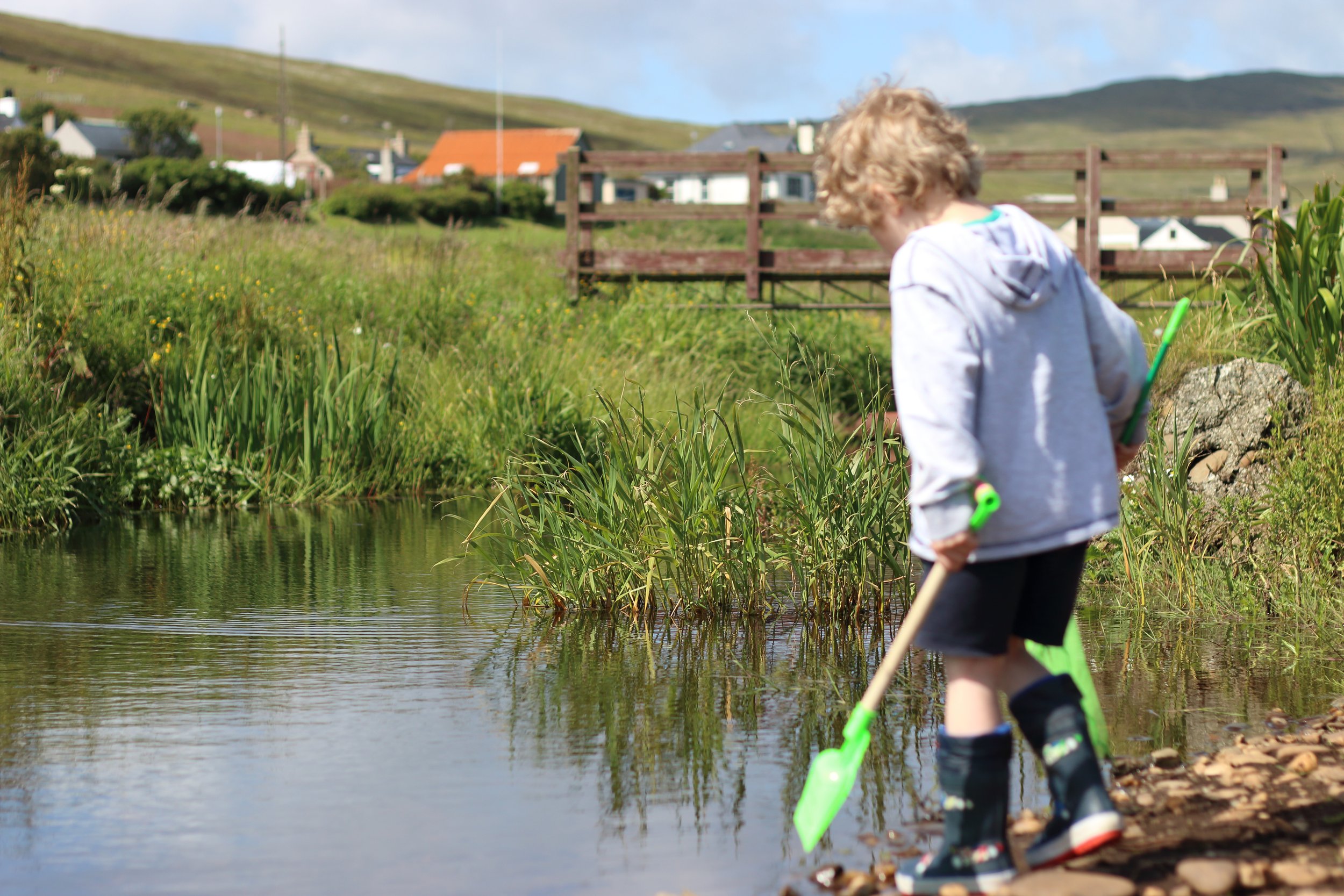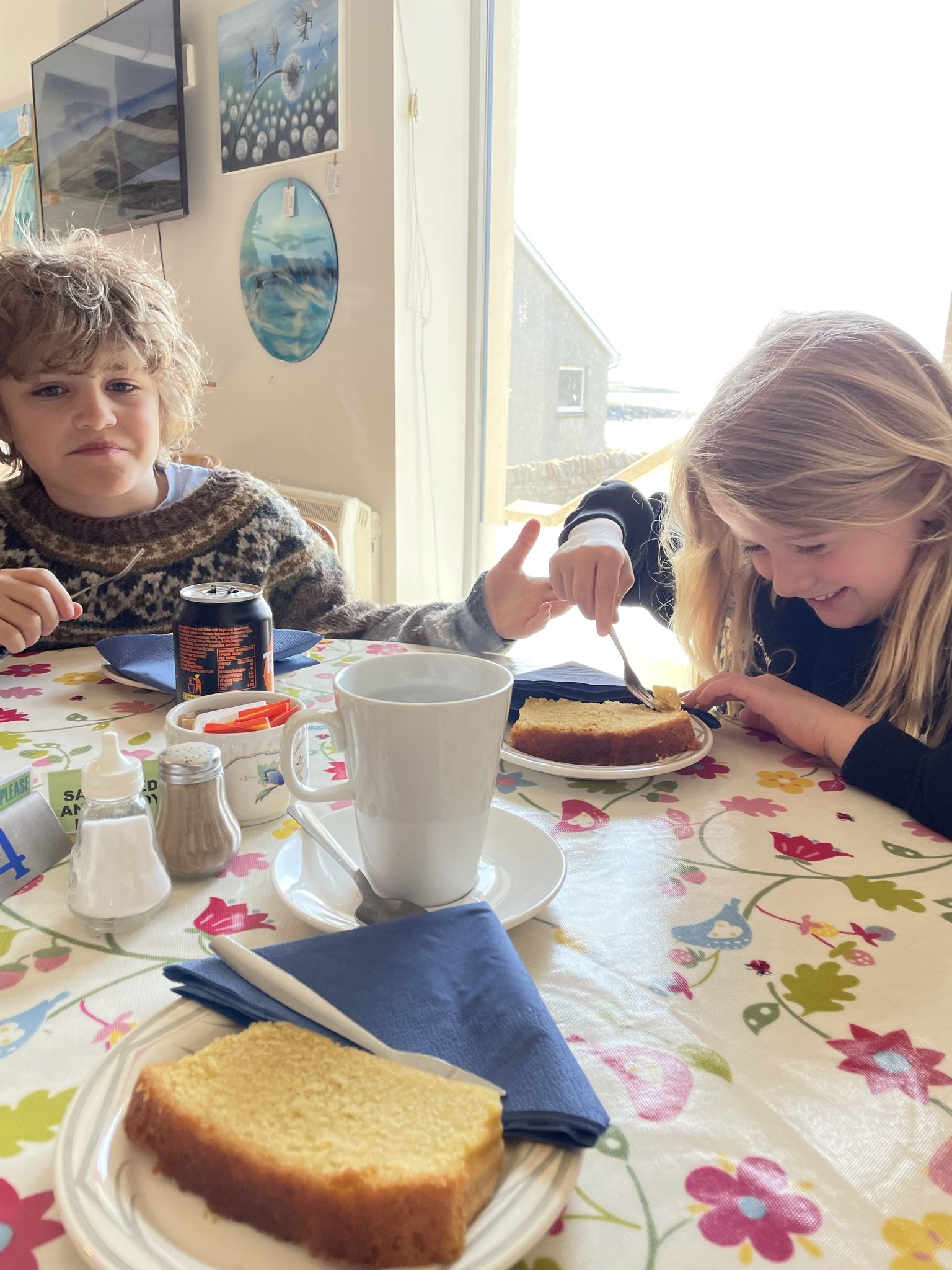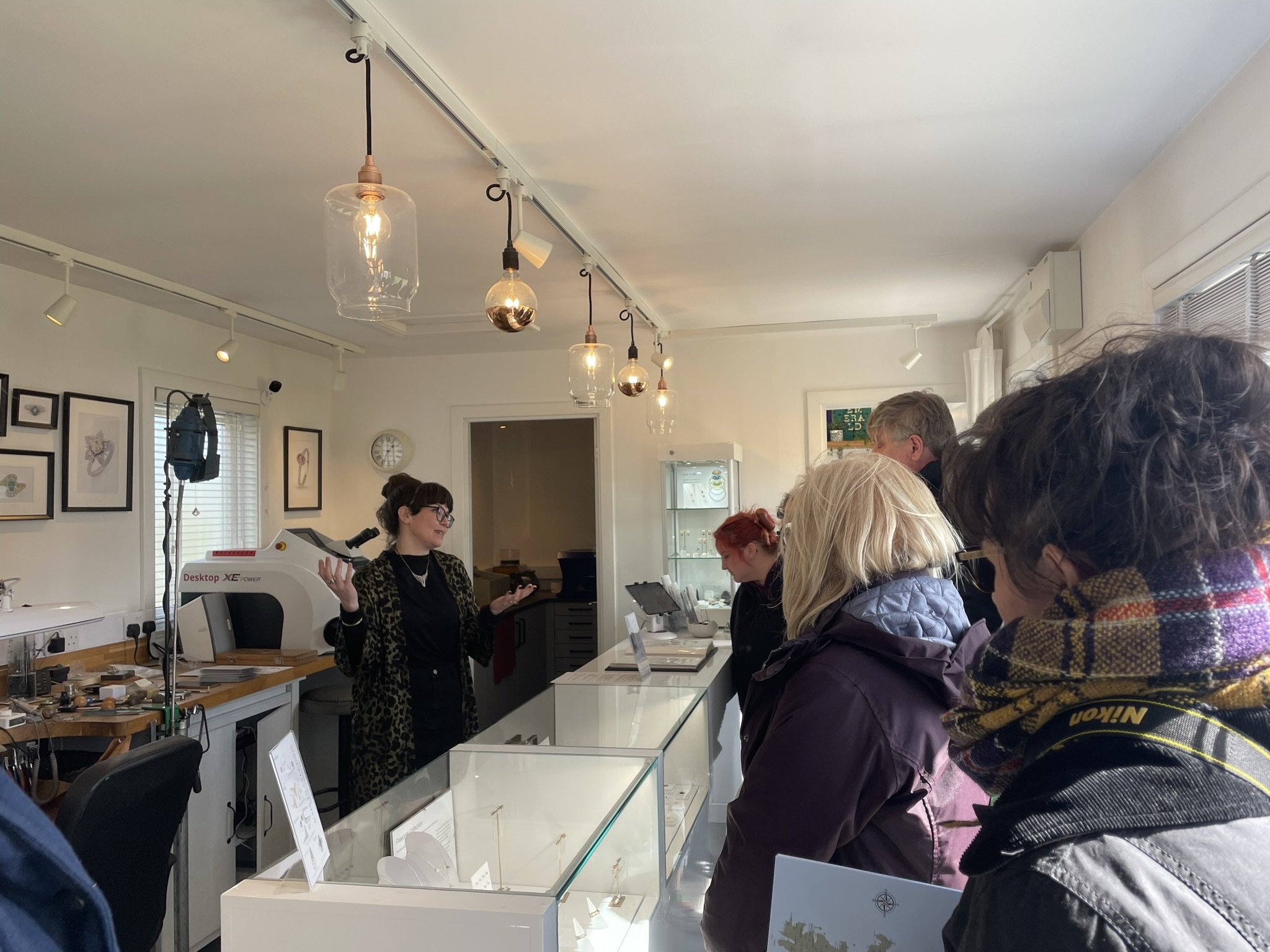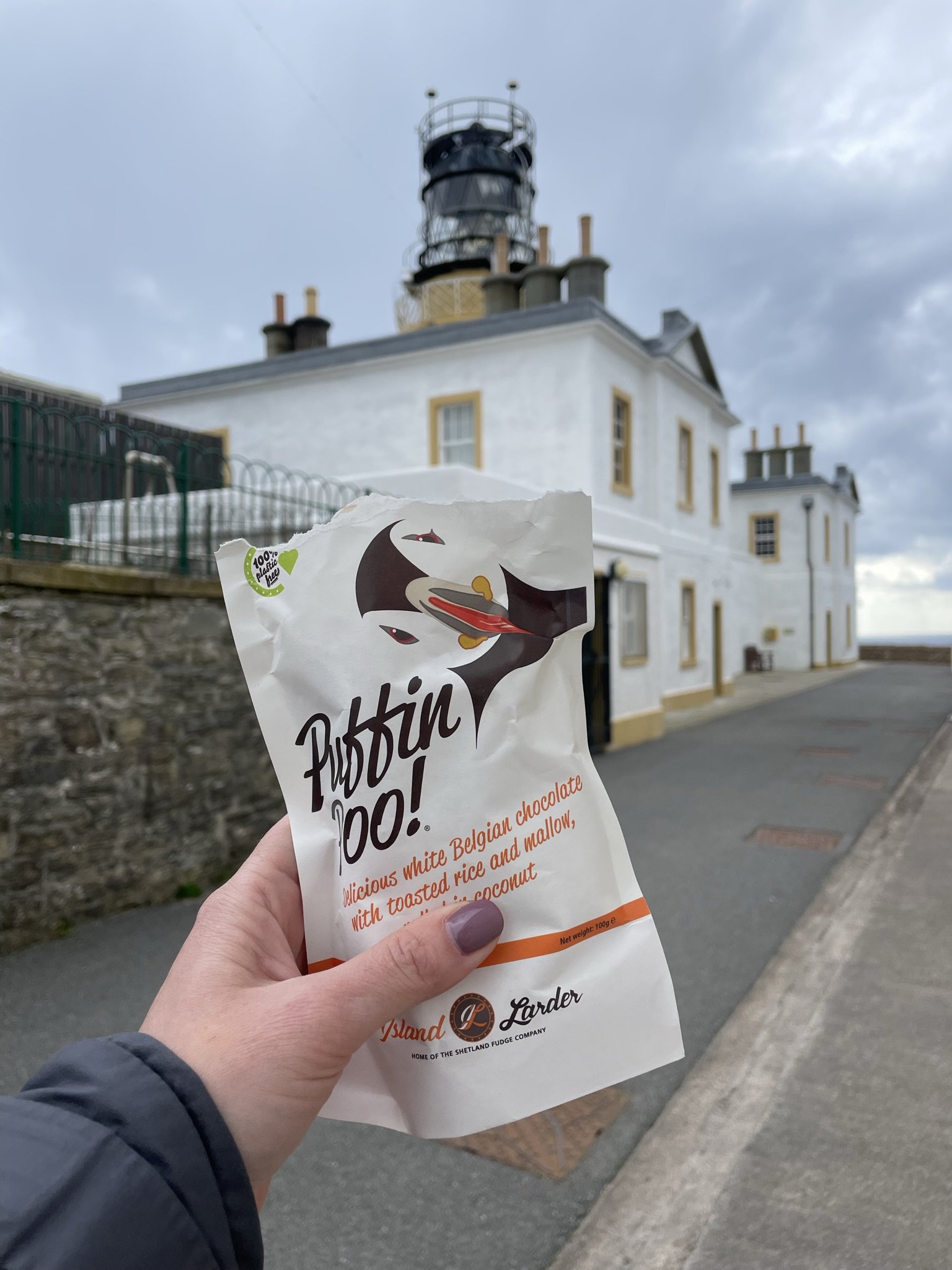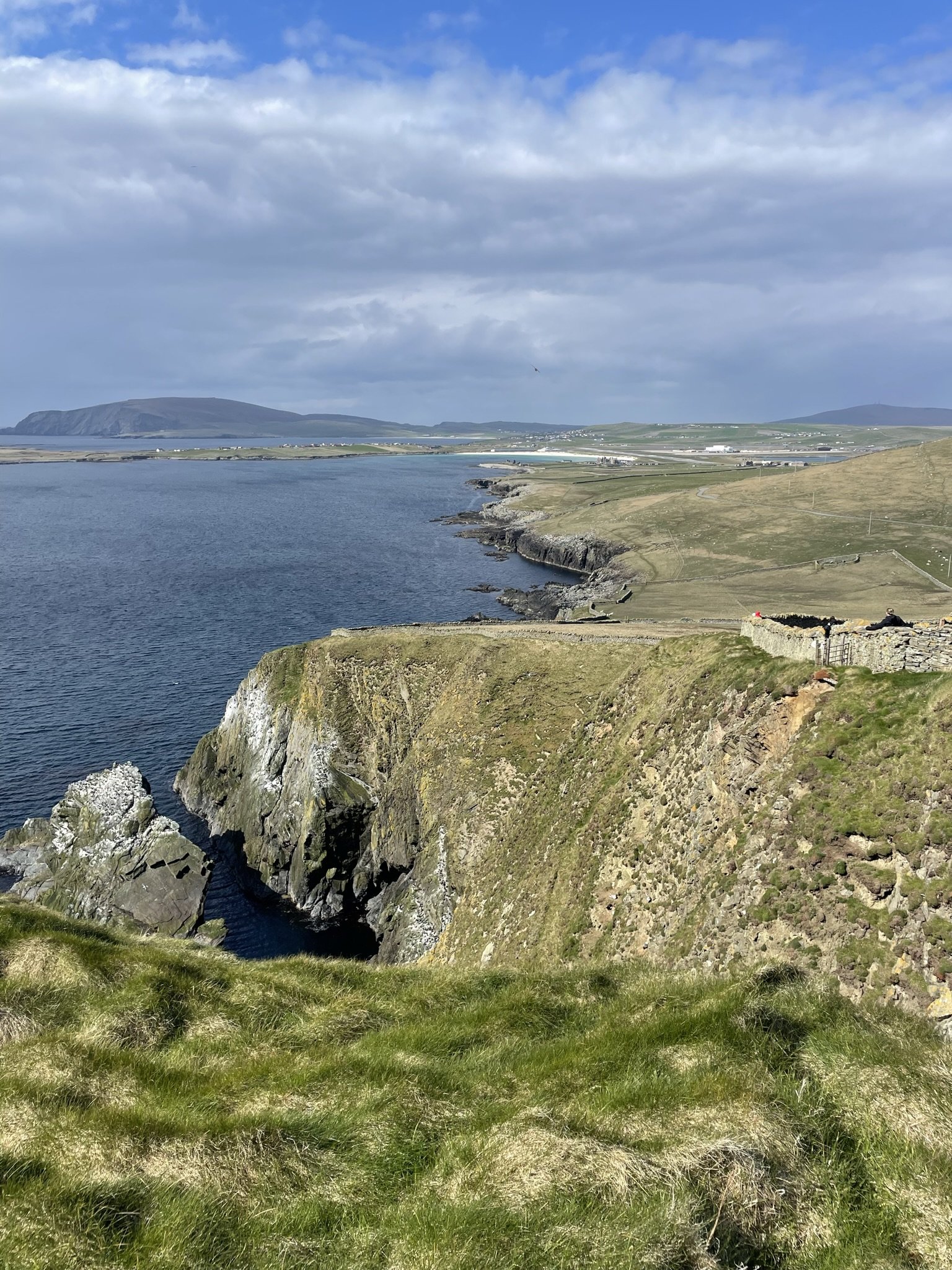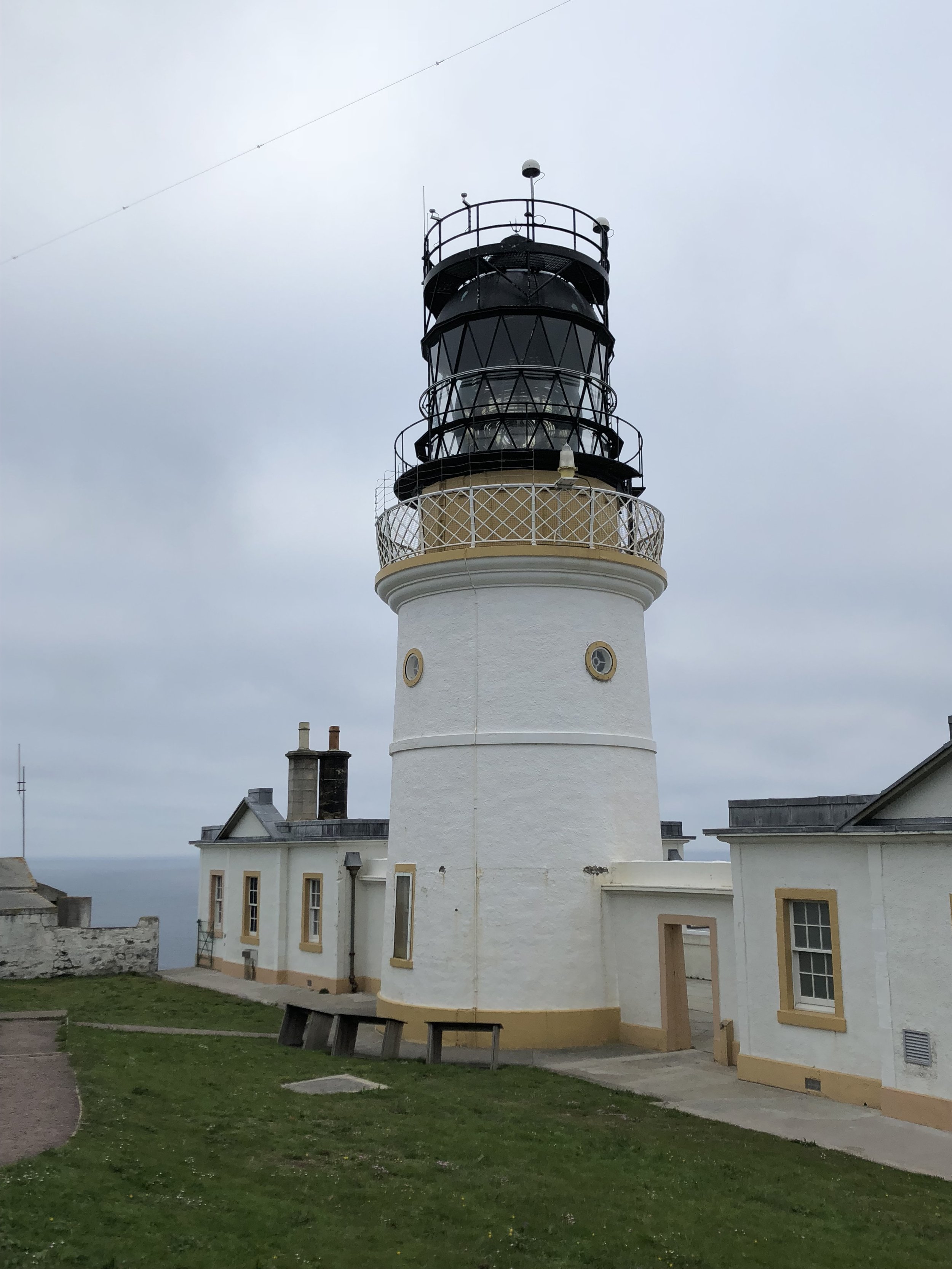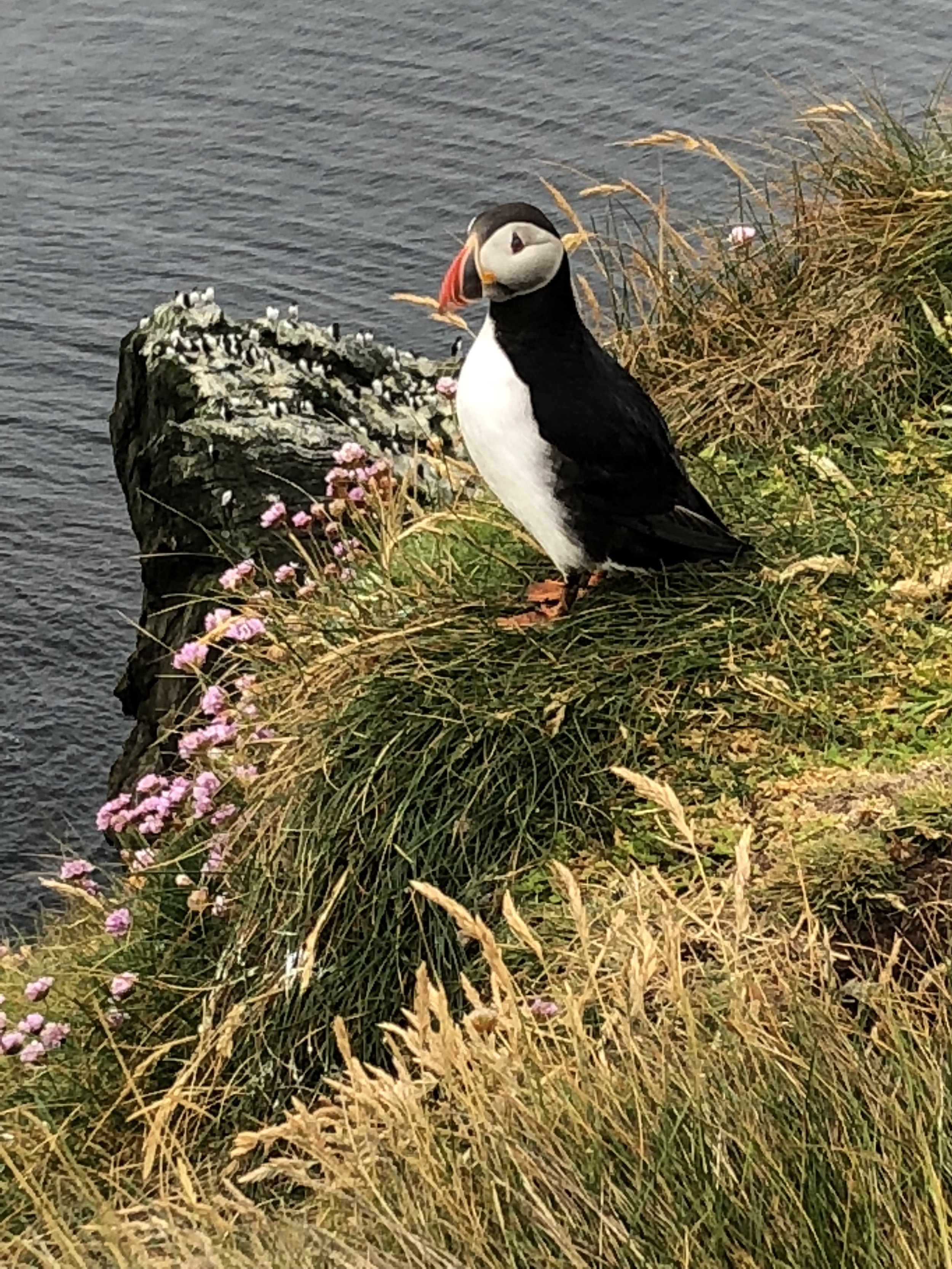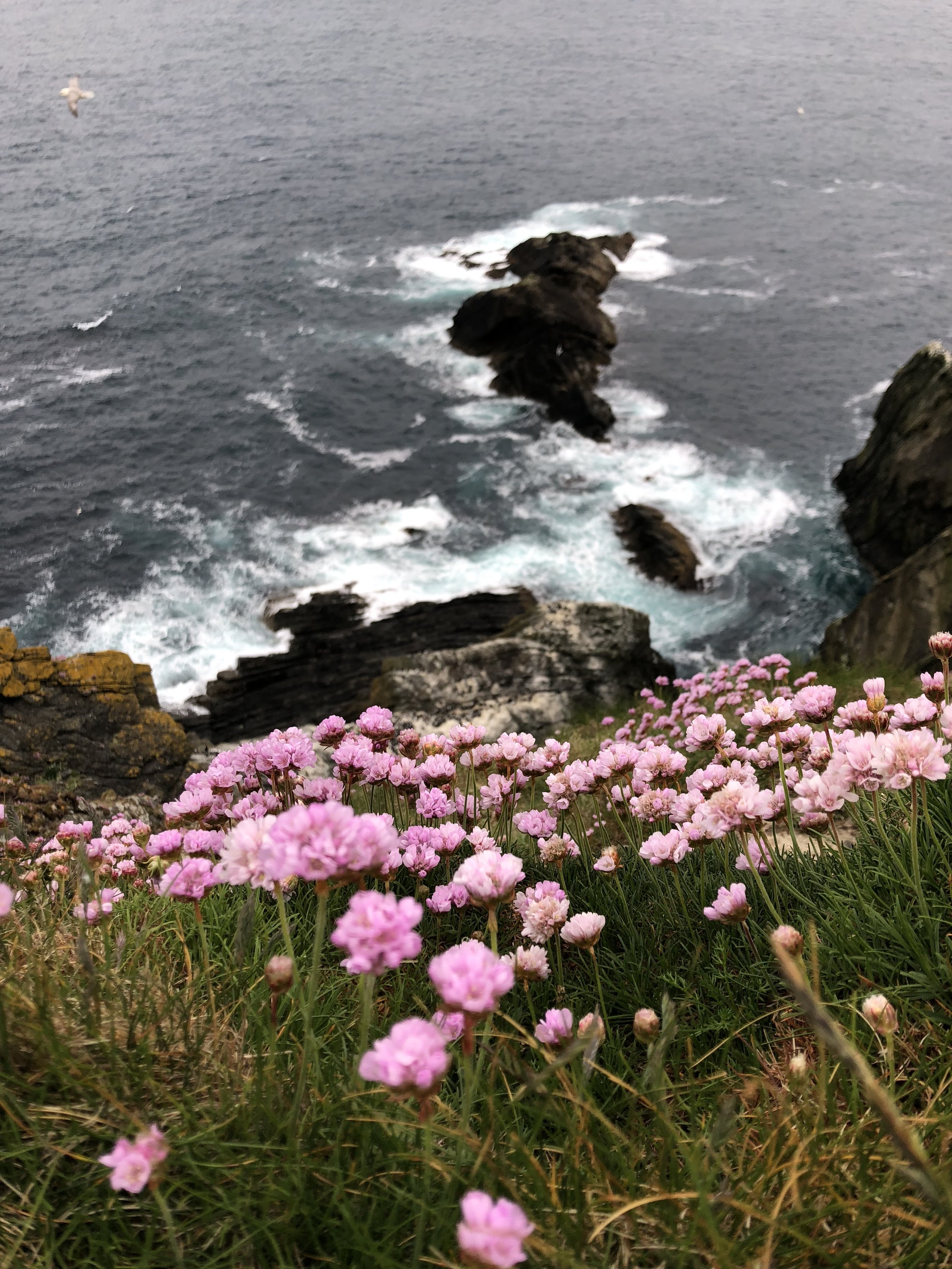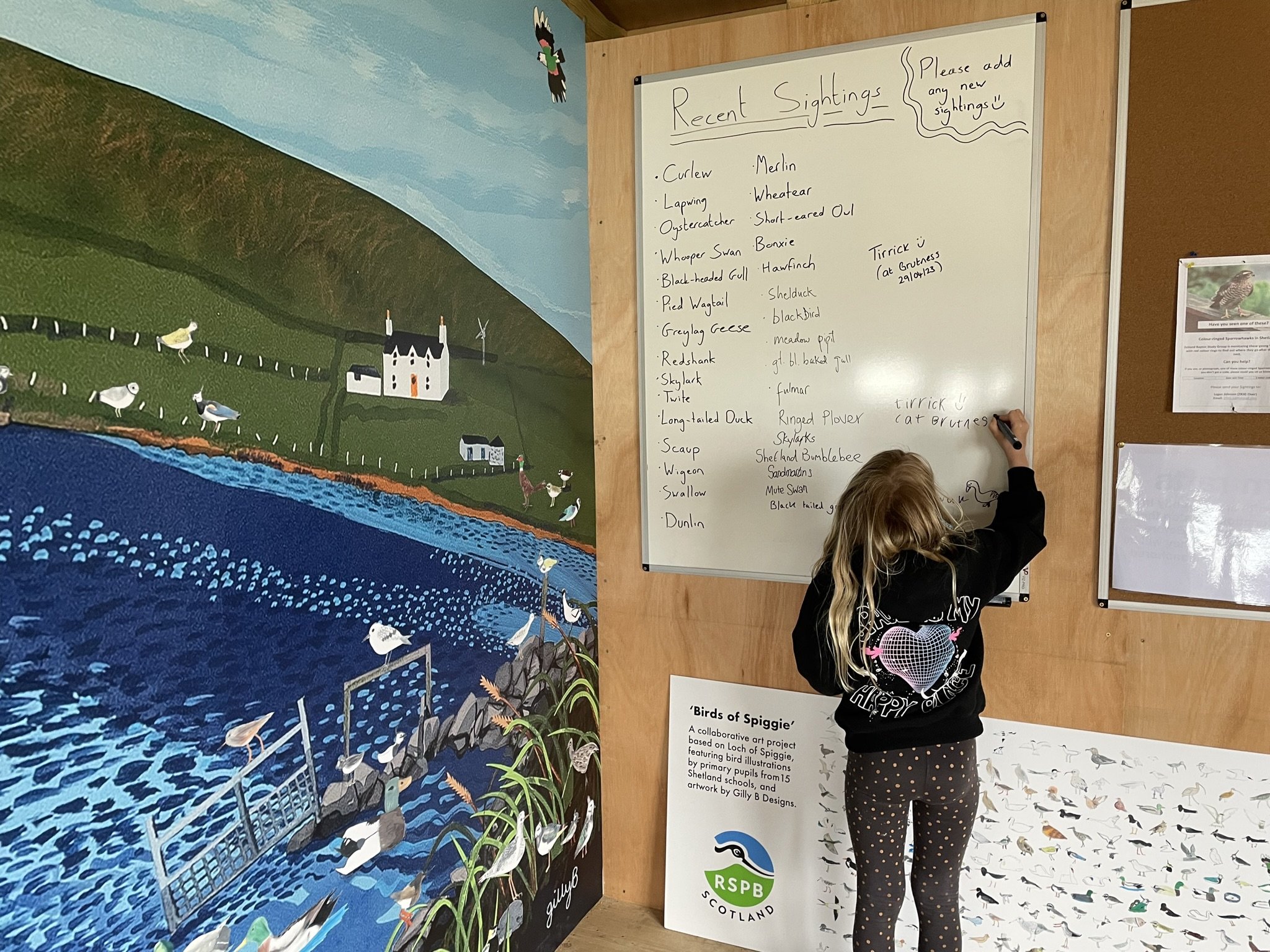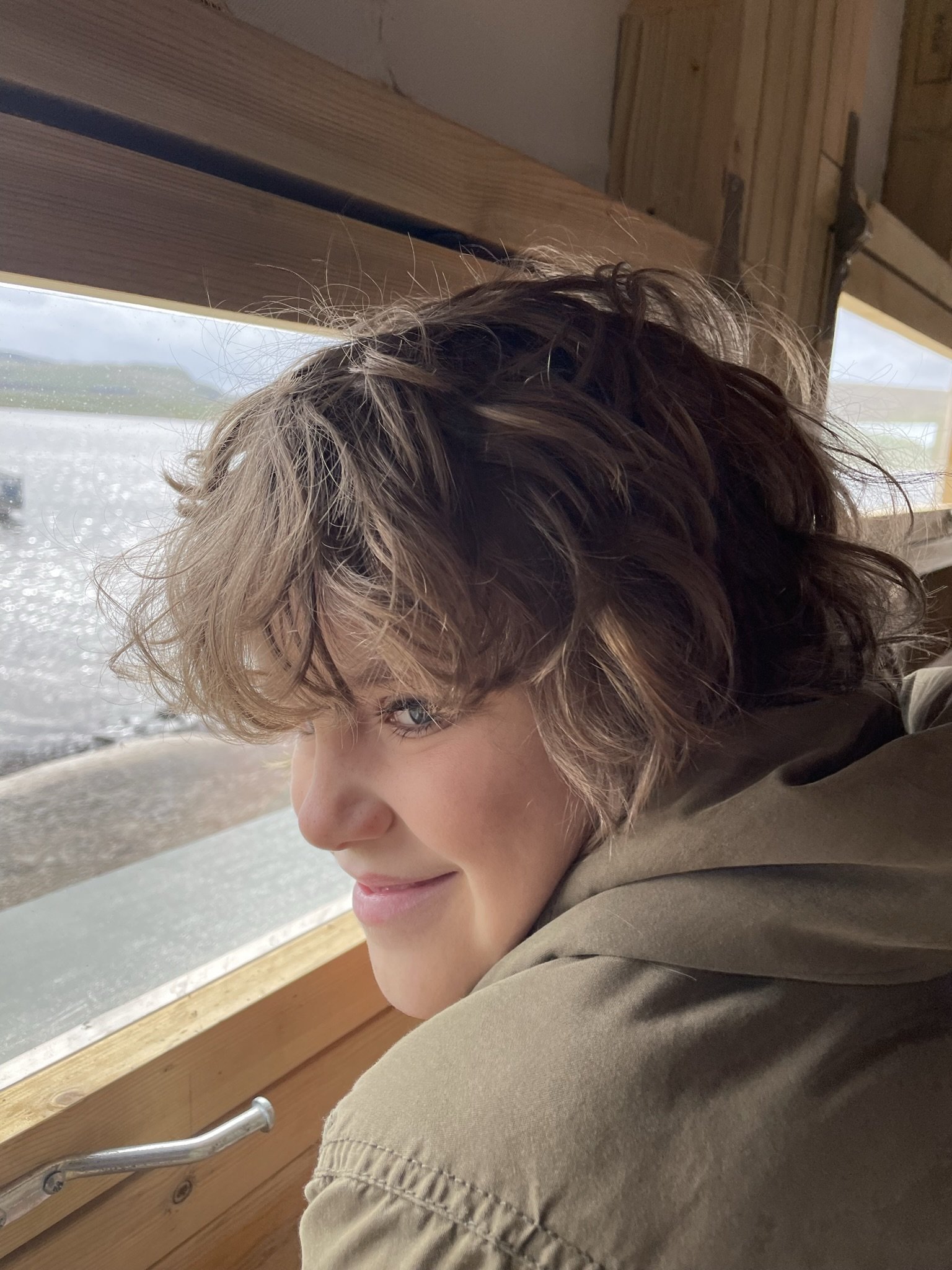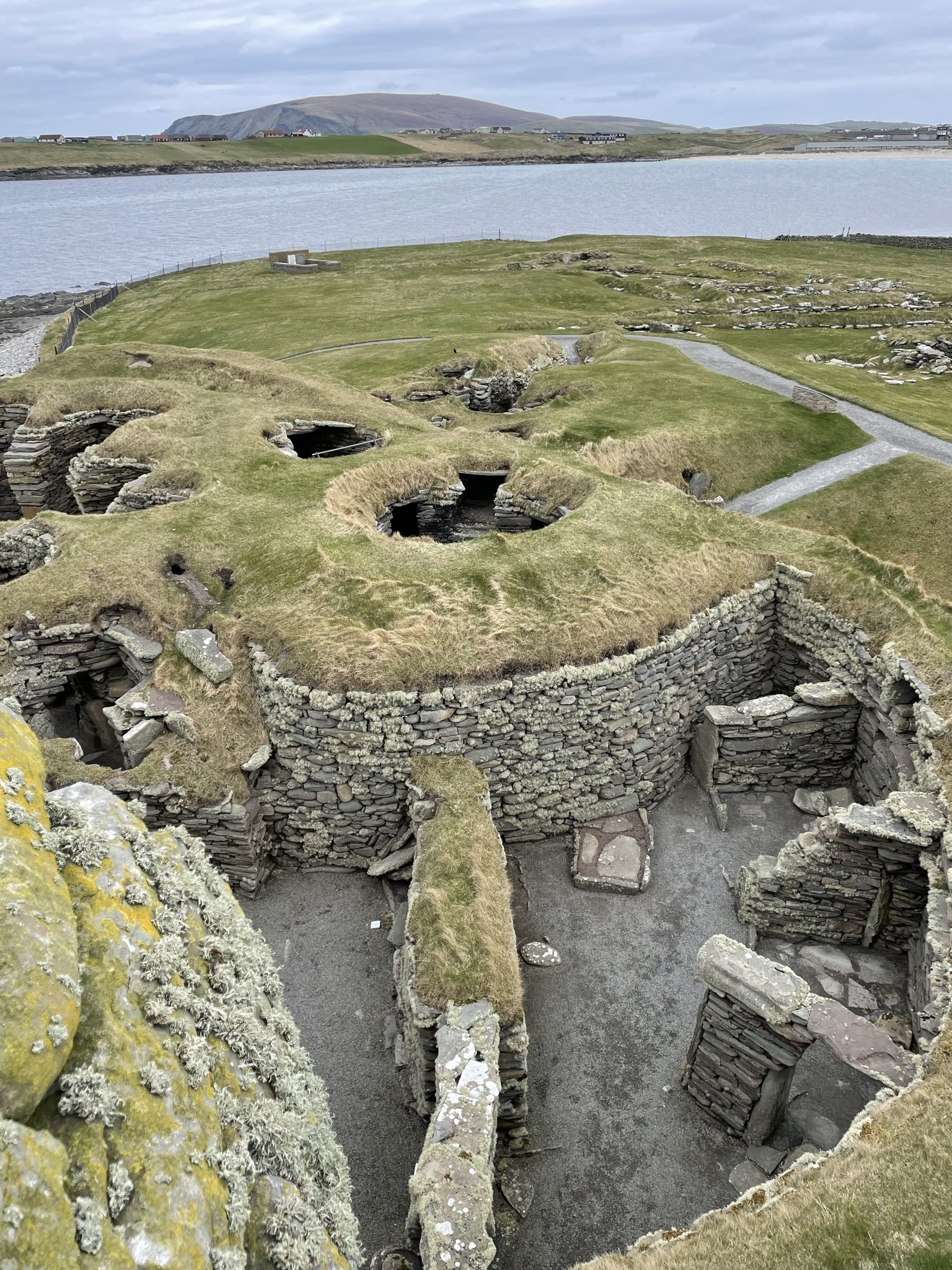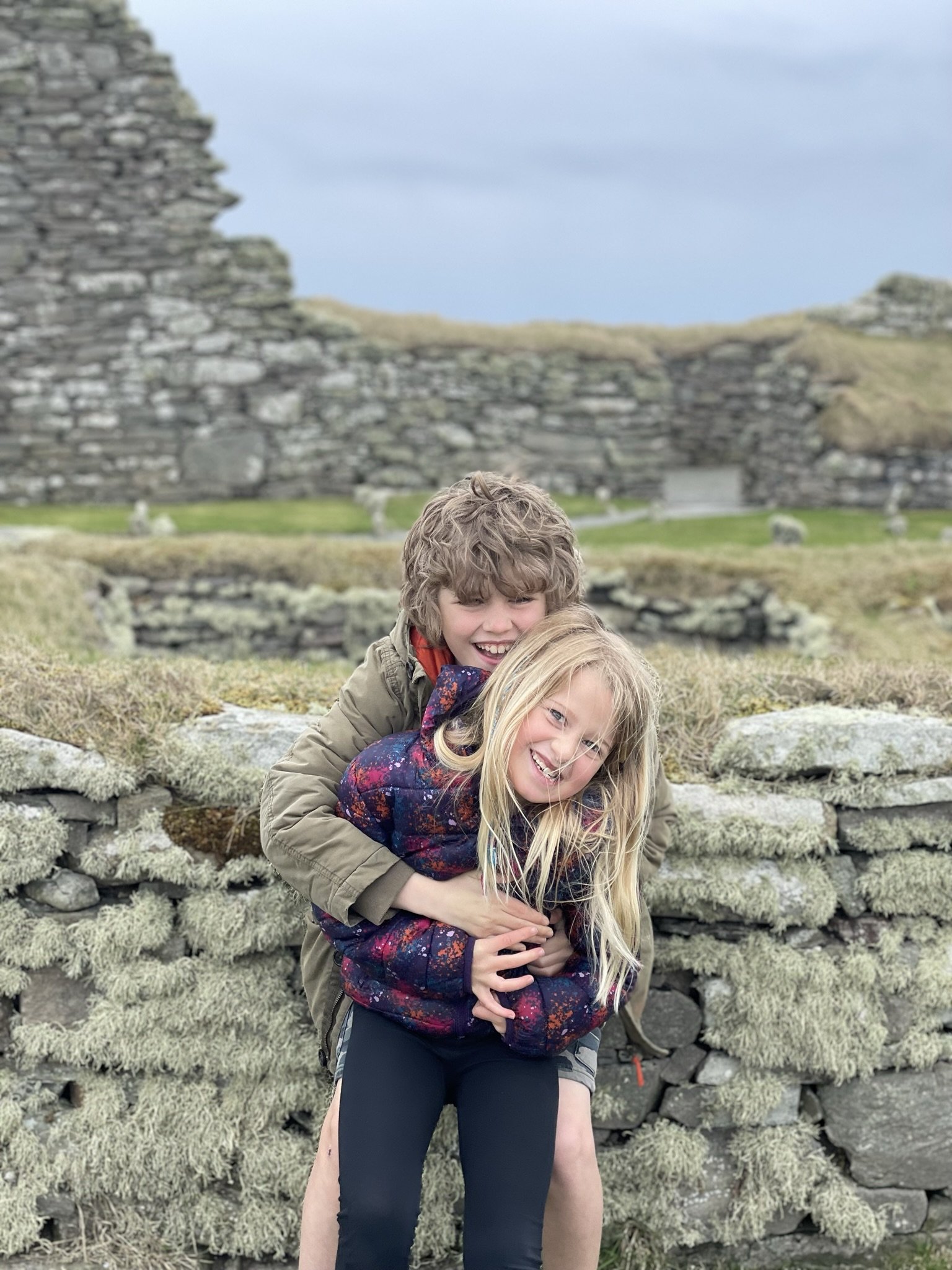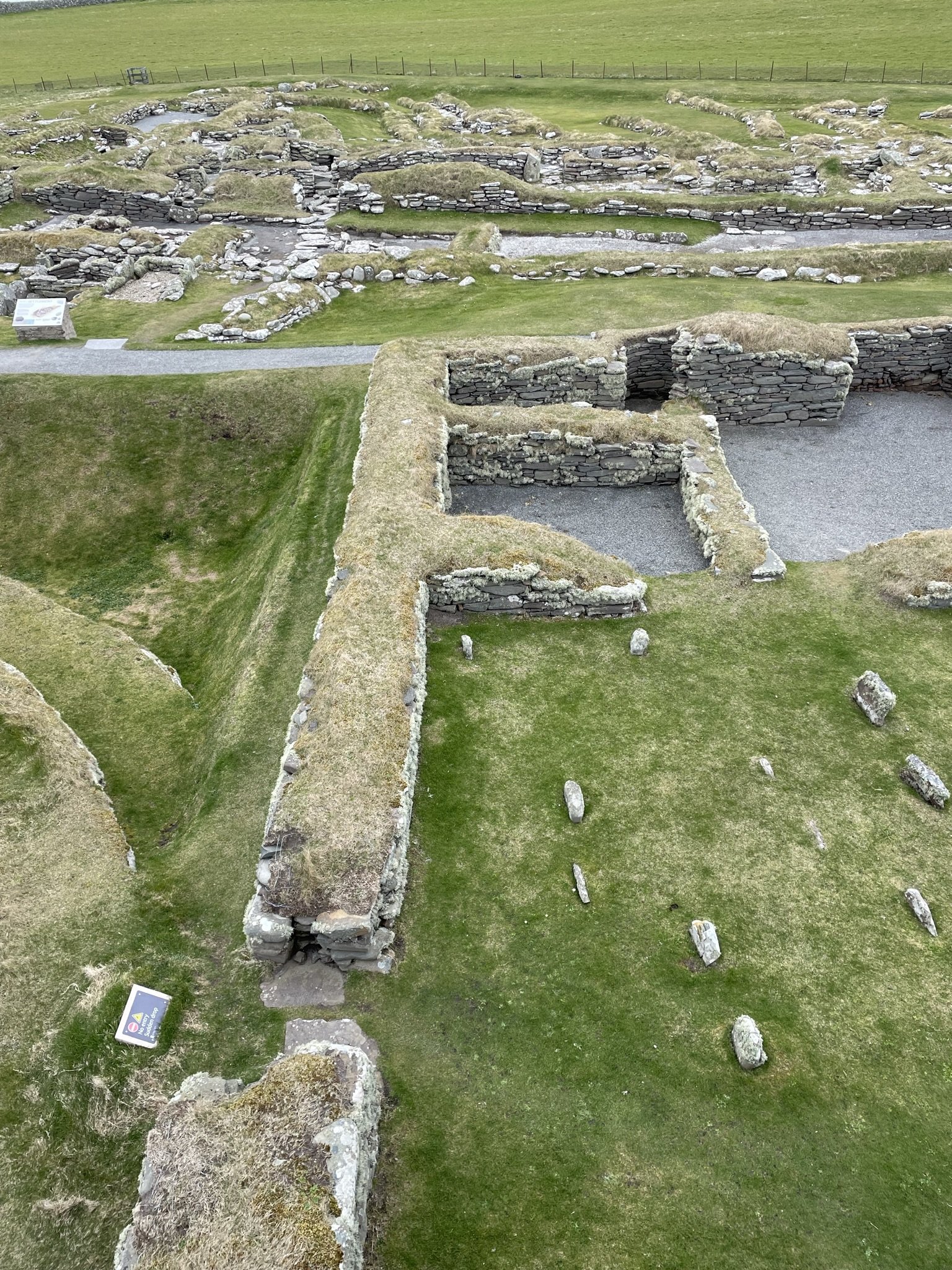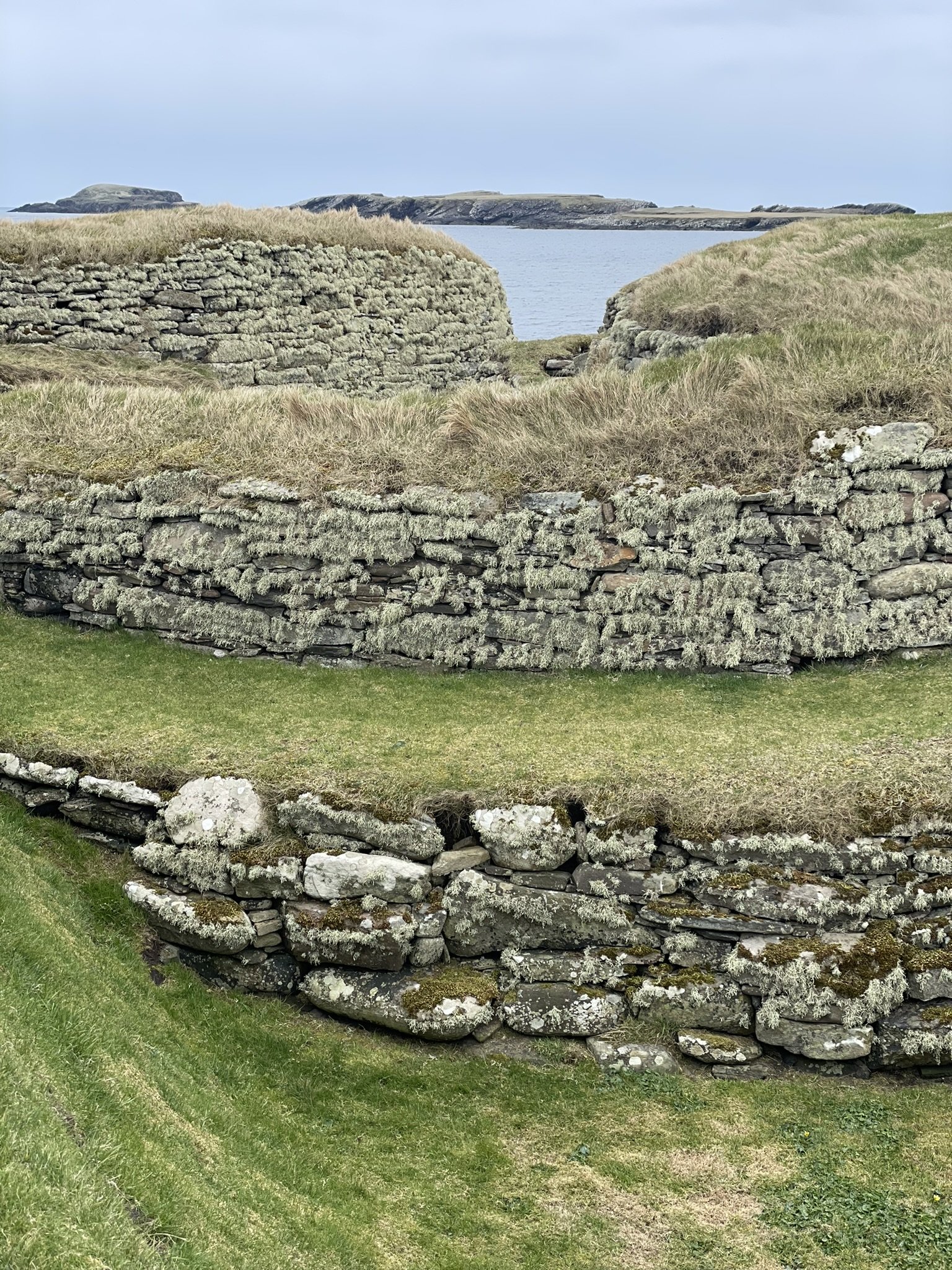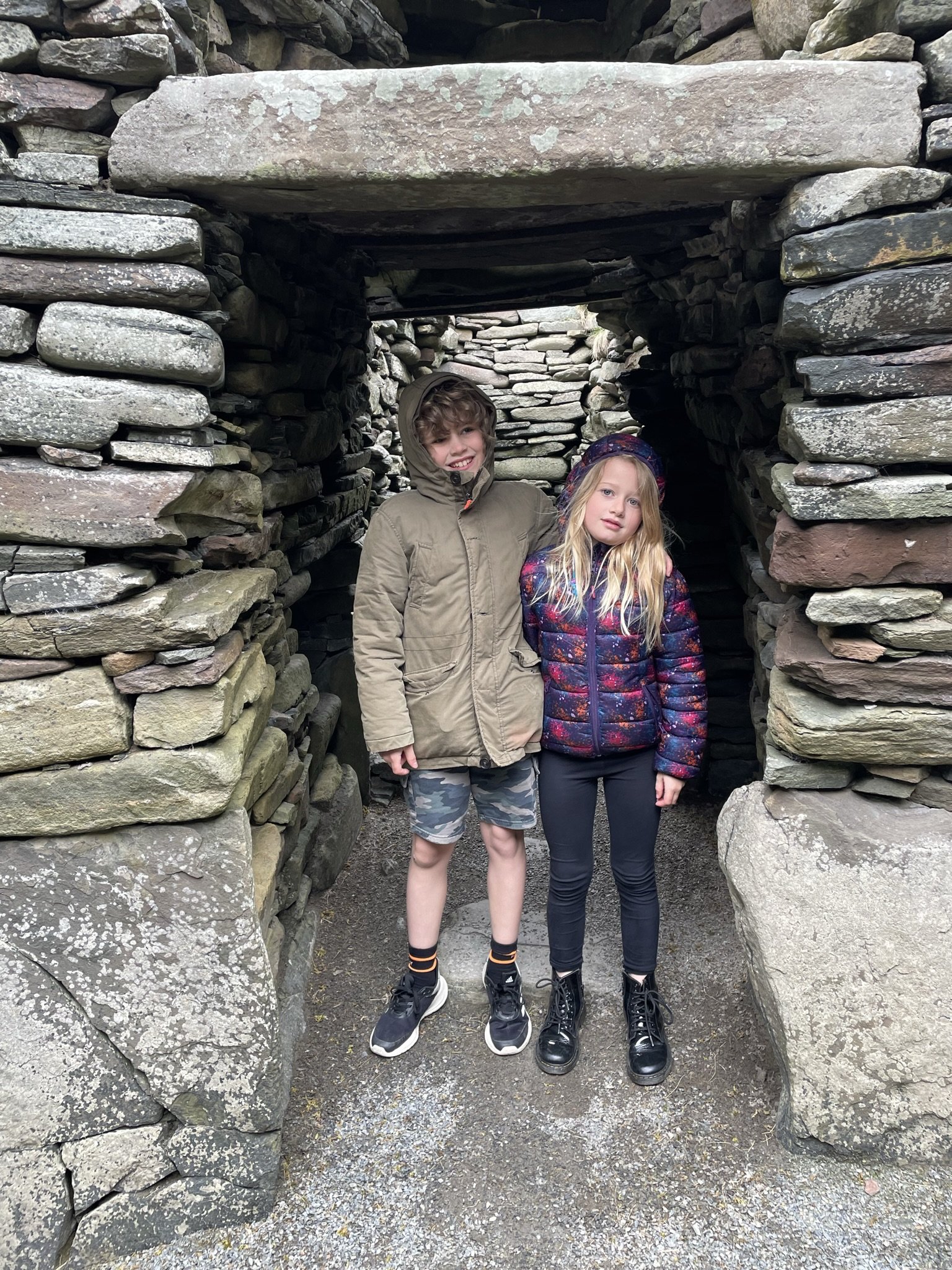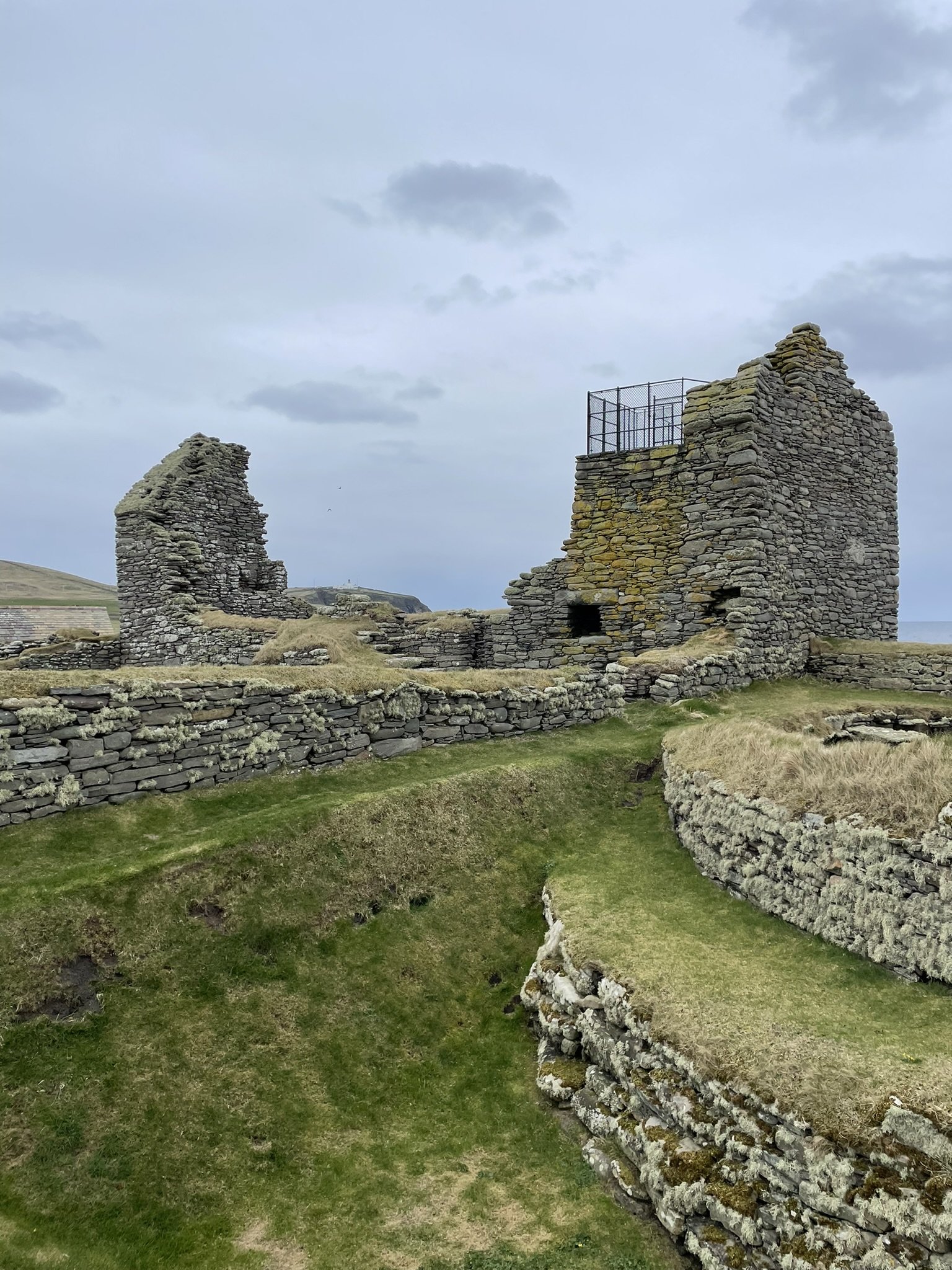Shetland Glamping – a step into the luxurious
Shetland Glamping pods at Rerwick, South Mainland
A few weeks ago, we were invited to come and stay at Shetland Glamping’s beautiful new pods at Rerwick. Enjoying incredible sea views across rolling countryside and out to sea, Shetland Glamping is the hottest new accommodation offering in Shetland’s South Mainland. After opening last summer, the guest book in our pod Shalder was already bursting with rave reviews for their luxurious ‘Mega Bunker’ Glamping Pods.
Glamping is a portmanteau of ‘glamorous’ and ‘camping’. It describes a style of camping with amenities and, in some cases, resort-style services not usually associated with ‘traditional camping under canvas.
The Oxford Dictionary defines glamping as ’a form of camping involving accommodation and facilities more luxurious than those associated with traditional camping’, but I would define Shetland Glamping as ’a form of luxury accommodation that challenges the boundaries of the conventional definition of glamping. The luxurious pods at Rerwick in Shetland’s sweeping South Mainland are a real break away from the idea that, with glamping, you have to forfeit some of life’s luxuries. Rerwick’s sleek and modern pods bear little resemblance to camping or ‘roughing it’ other than they feel so connected with the landscape they nestle within.
The site at Rerwick, a few miles south of Bigton, on the South Mainland’s fractured Atlantic coastline, contains two pods and the foundations of a third to be installed later this year or next. Each pod has a double bed, bunk beds and a sofa bed, allowing up to six guests. The pods also contain a spacious shower room, a well-equipped kitchenette and living and dining space, both inside and out. The underfloor heating, audio, and TV system make the experience feel far away from camping. With speedy WiFi, access to Netflix and a dreamy view across to Scousburgh Sands (Spiggie Beach), it wasn’t easy to think about leaving to adventure around Shetland’s most southerly parish.
I’d had a busy week and, if I’m honest, was feeling a little stressed and brain-frazzled when we arrived. Yet within moments, the incredible setting drew me in, and I felt the tension leave my body as I set myself up with a glass of wine and book on the decking; the late-April sun hung low in the sky, and the call of newborn lambs carried on a chilly spring breeze – this was an easy place to sit and daydream the evening away.
The South Mainland will likely be one of the first places you’ll see in Shetland as the island’s main airport is at the southernmost tip of the Mainland, at Sumburgh. The South Mainland is the long, narrow peninsula that protrudes south of the Central Mainland – and has been likened to the blade of a sword. Interestingly, the Old Norse name for Shetland was Hjaltland – or Hitland – and one theory is that this name comes from a sword’s hilt (hjalt).
Best known for its fertile farmland, rolling hills and beautiful sandy beaches, the South Mainland offers an often gentle landscape. However, it’s also an area of contrast, dominated by the rugged Clift Hills that run through the south like a spine, separating east from west.
Clavel, South Mainland, Shetland
Spanning only a few miles at its widest point and, at its narrowest, the width of the runway, the South Mainland is made from Old Red Sandstone, a sedimentary sandstone laid down in layers, providing relatively fertile soils, particularly around Quendale and Bigton, where most of the island’s crops are grown – and where the glamping pods at Rerwick, pronounced ‘Rurick’, are sited.
Stretching 25 miles from Lerwick to Sumburgh, taking in the villages of Cunningsburgh and Sandwick and the rural communities of ‘Da Ness’ before reaching the southernmost point of Sumburgh, the uninhabited islands of St Ninian’s Isle and Mousa are also found in the South Mainland – both of which are worth a visit whilst staying with Shetland Glamping.
Owners, John and Julie have poured so much thought and love into ensuring that a stay at their pods is a relaxing and carefree adventure. The beds were all freshly made, fluffy towels were provided, and Julie had laid out tea, coffee, hot chocolate, juice and biscuits in the kitchenette. The cooking facilities were brilliant, with everything provided to cook a meal, including a fridge, cooker and oven. I chose the easy option – pizza on the first night and pasta with salmon and a creamy sauce on the second.
Outside, a kid’s play area provides hours of entertainment with a climbing frame, swings and sand pit. Fire pits – with firelighters, matches, kindling and logs – are supplied for anyone who wants to BBQ or just toast marshmallows and watch the sunset.
An itinerary for your stay
We only had a weekend with Shetland Glamping, and I would recommend staying longer as this is an excellent place for exploring the South Mainland and beyond, but here’s a taster of what we got up to during our weekend in ‘Da Ness’.
Saturday
We had a slow morning; the glamping pods called for this. We woke with the sweet sound of birdsong and the eager cries of day-old lambs calling to their mothers in the surrounding hills. It was magic. The sun was already high in the sky, glistening off the turquoise water in the bay. Taking advantage of the perfect spring day, I enjoyed fresh eggs outside with unrivalled sea views. I struggled to tear myself away and get on with the day before it was spent.
Our first stop of the day was in Hoswick. Hoswick is a fantastic place to spend time, a beautiful village nestled under the hill just a mile from Sandwick. From the Hoswick Visitor Centre, a path to the beach leads to the shore, where you can search for pretty stones, shells and sea glass. Hoswick Burn is a great place to explore, with a relaxing quarter of a mile walk along the banks. The burn is teeming with tiny fish, so bring a pond net if you have children!
We enjoyed tea and cake at the Visitor Centre. The Centre is a fantastic community hub, boasting a cafe serving hot and cold food, local displays about weaving and fishing and a gift shop full of locally-made Shetland crafts.
If you’re visiting Hoswick, be sure to call along the local knitwear shops. Shetland Woollen Company (the sign above the door says Laurence Smith) has a fantastic collection of traditional Fair Isle and plain-knit woollen jumpers, scarves, hats and gloves, whilst next door, contemporary knitwear designer, Neilanell, offers an alternative to the traditional with vibrant, fun and colourful designs – the only problem you’ll have here is choosing one from her many unique designs!
Local jeweller, Karlin Anderson, has a beautiful studio overlooking the bay and always offers visitors a warm welcome – stop along and hear about her collections and the inspiring women behind them.
Karlin Anderson’s jewellery studio and shop, hoswick
Before leaving, we visited Hoswick Playpark – a community-run play area with a local feel. It features small boats, kayaks and lobster pots (creels), offering hours of fun for little people in your group.
After our cake stop, we visited Hymhus, a social project run by the Bigton Collective in the former Bigton Kirk. The Kirk provides a versatile space for community events, including exhibitions and concerts. However, we were there for two reasons; the charity shop and Gus’ freshly-baked baguettes, available every Saturday.
I filled the car’s boot with various odds and ends, including some second-hand LPs, an Ann Cleeves paperback from her Vera series, and a lovely granary baguette. The bairns found a wooden skittle set, a junior edition of Scrabble and a retro ball game. The grand total of my spending spree came to less than £15.
Back on the road, we passed the pods on our way south, passing via Rerwick Beach and Scousburgh (Spiggie) Sands, where the views from the road are stunning. Rerwick and Scousburgh are two beaches that face each other in the Bay of Scousburgh – the views across from the pods are out to Scousburgh Sands or Spiggie.
Rerwick is a beach best viewed from the road, as there are often close to 50 seals hauled up enjoying the sunshine. It’s best to leave this beach to the wildlife and, after watching the seals relaxing for a moment from the layby above the beach, head over to Scousburgh Sands. Information about the sensitive area and accessing the outdoors is available within each pod, and it’s important to respect the seals and give them privacy and space.
Rerwick Beach with seals
Scousburgh Sands (often known as Spiggie) is a beautiful white sandy beach that faces north towards Rerwick. Geologically speaking, it’s fascinating as it was formed by a mid-bay bar that grew close to the end of a long voe, eventually cutting off the voe and forming a dune and machair system. Behind the beach are impressive dunes and the Spiggie Loch, a favourite spot for birdwatching and trout fishing. The beach is fantastic for a wild swim or just a stroll along the sand – particularly at sunset.
Scousburgh (Spiggie) sands
We picked up a picnic, including local bread from Sandwick Bakery, and parked beside the Grutness beach overlooking the airport. Grutness Beach is close to where the ferry to Fair Isle departs from, and while enjoying lunch, I spotted my first tern of the season. Shetland hosts both common and Arctic terns, known locally as tirricks, throughout the summer breeding season. These elegant – if fierce – little birds are often considered the harbingers of summer, with their piercing calls providing a chorus throughout the summer months. It’s no secret that these are my favourite birds!
West Voe, on the opposite side to Grutness, demonstrates Shetland’s rich past with prehistoric evidence spanning millennia. Shetland’s prehistoric past lay buried for centuries along this pristine expanse of glittering white sand, a popular walking spot. Archaeological excavations on a shell midden revealed evidence of Late Mesolithic people exploiting the shoreline for food. Radiocarbon dating placed the midden back some 6,000 years. West Voe was the first Mesolithic site discovered and dated in Shetland. This fascinating beach demonstrates that visitors have been coming to Shetland for at least 6,000 years – the islands are indeed tried and tested!
Westvoe Beach, Sumburgh
Whether you are arriving or departing, this beach beside the airport is the perfect place to soak up some of Shetland’s fresh Atlantic air carried in on the stiff sea breeze.
After lunch, we headed to Sumburgh Head to see if we could see a puffin. Of all Shetland’s nature reserves, Sumburgh Head’s RSPB reserve is probably the most accessible for those who are not keen walkers but want to get up close and personal with nature. Sumburgh Head lies on the southernmost point of Mainland Shetland and enjoys commanding views out to sea and across the ‘Roost’ to the most southerly of the Shetland Isles – Fair Isle.
Sumburgh Head is home to an array of breeding seabirds, including; guillemots, shags, fulmars, kittiwakes and puffins. Gannets, great skuas and terns can also be seen feeding in the rich fishing waters around the Head. The puffins are the real star of the show at Sumburgh Head, where visitors can get to within a few feet of these enigmatic little seabirds. Orcas and other cetaceans are frequently seen passing through the area in search of feed, so this is a must-see for wildlife.
But it’s not just wildlife that draws visitors to the southernmost extremity of Shetland; the lighthouse dominates the headland and has played an essential role in Shetland for generations. It was built by the famous ‘lighthouse’ Stevenson family and completed in 1821. A keeper and his family lived in the lighthouse until the light was automated in 1991.
We didn’t see any puffins and instead explored the Marine Life Centre, where fantastic displays about Shetland’s marine environment tell a wider story. Afterwards, we bought a bag of Puffin Poo (a delicious sweet treat made by Island Larder) and happily munched it as we strolled back down the hill to the car.
On the way back to Rerwick, we stopped at the RSPB hide at Spiggie Loch to record our happy tirrick spotting on the ‘Recent Sightings’ board. The hide is a beautiful place to watch the birdlife on the water with a fun and colourful mural on the wall by local artist Gilly B.
I had grand plans to spend the evening stomping the hills – I had planned on either Fitful Head or around Noss – but him indoors had gone home with a nasty cold, so me and the bairns opted to light the fire and enjoy a fire pit instead.
Fitful Head is a challenging walk – about 5.5 miles (9 km). Your efforts are rewarded at the top with stunning panoramic views looking south towards Sumburgh Head and north up the west coast of Shetland. A poignant memorial is found in the cliffs in the upper reaches of Fitful, commemorating the crew of a Halifax Bomber that crashed when returning to Sumburgh following a mission. Seven crewmen were lost. Fitful is also an excellent spot to catch a summer sunset.
The cliffs around Noss are a more leisurely hike and somewhat unexpected amongst the gentle landscapes of the south. Noss is also the site of a Second World War radar station, and many of the original buildings still stand, but, for me, the coastal scenery makes this place unique.
Sunday
Sunday, as is usually the case, came too fast and marked the end of our weekend with Shetland Glamping, but we had one more site to visit before hot-footing back to Lerwick to enjoy some of the annual Shetland Folk Festival.
After packing up, we headed back south to Jarlshof, a fascinating site on the southernmost tip, where the North Sea meets the Atlantic Ocean. Jarlshof is one of Europe’s largest multi-period sites, boasting an almost uninterrupted occupation from the first Neolithic farmers until the 1600s when the Stewart Earls ruled.
One of the fascinating things about the site at Jarlshof is that there are 5,000 years of almost uninterrupted occupation here, giving us a clear picture of settlement in Shetland through the years.
The site is a must-see for anyone visiting Shetland; laid out chronologically, visitors weave their way through the ages of Shetland’s human history. From the first farmers of the Neolithic through the Bronze Age, Iron Age, Broch period and the arrival of the Vikings. Following a period of Norse rule, Shetland became part of Scotland, and we see an era dominated by the Scottish Lairds. Visitors conclude their walk through time with the now ruinous but once grand Laird’s house of 1600.
We spent a loooong time on the site as the bairns love the freedom they have to explore the ruins, and although their focus was on hide and seek rather than prehistoric society, I can’t help but feel that we are incredibly privileged to have this type of place on our doorstep.
In the afternoon, after unpacking our odds and sods from the Hymhus, we made our way to the Lerwick Legion to catch one of the last shows of the Folk Festival. Shetland’s Folk Festival has been held annually since its inception in 1981. It brings together musicians and audiences from all over the world in a weekend of good music and good company throughout Shetland.
Rounding off the weekend with shetland folk festival
We enjoyed our time at Shetland Glamping – I only wish we had longer! Bookings can be made on the website, but as it’s popular, book sooner rather than later. It is a minimum two-night stay. However, I’d recommend booking a longer stay as an automatic 10% discount will be applied at booking for 4, 5 and 6-night stays, whilst 7+ night stays will benefit from a 15% discount.
The standard nightly rate is £110 per pod per night during peak season (1st April to 31st October, festive period and Lerwick Up Helly Aa week), reduced to £90 per night at all other times. They also offer a special off-season price – a 2-night weekend stay (Fri/Sat or Sat/Sun) for £150; this offer runs from November 2023 to March 2024 (excluding the festive period and Up Helly Aa).
Here are a few more ideas for your stay
St Ninian’s Isle
Believe it or not, we never made it to St Ninian’s Isle during this visit, but if you are visiting for the first time, this is likely to be close to the top of your list of places to see. St Ninian’s Isle is probably Shetland’s best-known beach. Its iconic image is found in most brochures and internet searches for places to visit in Shetland, and rightly so. St Ninian’s Isle is a picture-postcard pristine white sand tombolo that connects the Shetland Mainland to the now-uninhabited St Ninian’s Isle. A 9th-century treasure hoard was discovered on the island when excavating a 12th-century Chapel site in the 1950s and is now displayed in Edinburgh’s National Museum, with replicas on display in the Shetland Museum & Archives.
Mousa
Mousa broch
It’s no secret that Mousa is one of my favourite places in Shetland. Mousa, an uninhabited island off the east coast of the South Mainland, takes its name from the Old Norse “Mossy Island” and sits on the 60° North latitude line, helpfully marked by a beautiful wooden bench, made from reclaimed driftwood that washed ashore on the isle and was crafted into a contemplative place to sit by Mousa Boat’s skipper, Rodney Smith.
Mousa has been inhabited since prehistoric times, and, despite being no more than one-and-a-half miles long and one mile wide, it helps explain the story of Shetland’s human history from the Neolithic to the present day. With remains of a neolithic homestead, Bronze Age burnt mound, Iron Age broch and the ruined remains of a 19th-century croft and haa house, the island offers us a tantalising glimpse into times past.
The highlight of any trip to Mousa is the impressive 2,000-year-old broch – the best example of an Iron Age broch anywhere in the world.
Mousa Broch stands 13 metres tall with a stone staircase that leads to the top of the giant drystone structure and is home to a breeding colony of storm petrels. This tiny seabird lives within the broch walls (Mousa Boat also offer evening tours around midsummer to witness these incredible birds returning to their nests).
Getting to Mousa is easy. The Solan IV, better known as The Mousa Boat, operates daily trips into the isle from the Sandsayre Pier, near Sandwick (unless otherwise specified). Daytime bookings are not required (£18 for adults; £8 for children).
Ness of Burgi
The Ness of Burgi is almost at Shetland’s southernmost point – it’s the neighbouring headland that looks across to Sumburgh Head and is home to an impressive Iron Age block fort. The walk is about two miles (3.25 km) and will take around an hour.
This fort is one of at least three block forts known to have been in Shetland during the Iron Age. Other examples are found at Clickimin Broch and in Whalsay. Ness of Burgi is about 2,000 years old and contemporary with the brochs. The fort is about 23m by 5.5 with walls that stand about 1.5 metres high today. It contains a central passage and two large chambers to the north and south.
Top tip: Walking here in June is beautiful as the headland hosts a carpet of sea pinks or thrift.
Crofthouse Museum
Shetland’s Crofthouse Museum (open May to September) is a traditional but-an’-ben thatched cottage, styled as it would have been in 1870s Shetland and complete with a working peat fire. Set in a picturesque setting near the village of Boddam, this delightful 19th-century gem shows how people in Shetland lived in the past, with box beds for the family to sleep in and an adjacent barn and byre to help support the crofting way of life. Custodians are always on hand to help interpret the buildings for visitors and paint a picture of what life in the 19th century would have looked like.
Quendale Mill
Visit the restored 19th-century watermill at Quendale and discover more about the milling traditions of the islands.
Old Scatness Broch and Iron Age Village
Old Scatness is a complex and fascinating archaeological site. The broch and surrounding village were accidentally discovered in 1975 whilst building a road to the airport.
Catpund Quarry
This fascinating Viking site is halfway between Cunningsburgh and Sandwick where carvings in the rock show where Viking and Norse settlers carved their bowls from the stone. It’s not well signposted, but look for the old road and the stream that leads up the hill!
We had the most memorable weekend staying at Shetland Glamping, and for anyone visiting Shetland, this would be an ideal base for a longer stay, so don’t be afraid to book a whole week – or more! Thank you to John and Julie for having us; we can’t wait to return!
Ways you can support my work…



